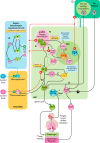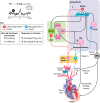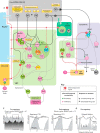Carotid Bodies and the Integrated Cardiorespiratory Response to Hypoxia
- PMID: 29897299
- PMCID: PMC6088141
- DOI: 10.1152/physiol.00014.2018
Carotid Bodies and the Integrated Cardiorespiratory Response to Hypoxia
Abstract
Advances in our understanding of brain mechanisms for the hypoxic ventilatory response, coordinated changes in blood pressure, and the long-term consequences of chronic intermittent hypoxia as in sleep apnea, such as hypertension and heart failure, are giving impetus to the search for therapies to "erase" dysfunctional memories distributed in the carotid bodies and central nervous system. We review current network models, open questions, sex differences, and implications for translational research.
Figures





Similar articles
-
Carotid body inflammation and cardiorespiratory alterations in intermittent hypoxia.Eur Respir J. 2012 Jun;39(6):1492-500. doi: 10.1183/09031936.00141511. Epub 2011 Dec 19. Eur Respir J. 2012. PMID: 22183481
-
Carotid body potentiation induced by intermittent hypoxia: implications for cardiorespiratory changes induced by sleep apnoea.Clin Exp Pharmacol Physiol. 2009 Dec;36(12):1197-204. doi: 10.1111/j.1440-1681.2009.05213.x. Epub 2009 May 19. Clin Exp Pharmacol Physiol. 2009. PMID: 19473190 Review.
-
Cardiovascular and ventilatory acclimatization induced by chronic intermittent hypoxia: a role for the carotid body in the pathophysiology of sleep apnea.Biol Res. 2005;38(4):335-40. doi: 10.4067/s0716-97602005000400004. Biol Res. 2005. PMID: 16579514 Review.
-
Carotid body chemoreflex: a driver of autonomic abnormalities in sleep apnoea.Exp Physiol. 2016 Aug 1;101(8):975-85. doi: 10.1113/EP085624. Exp Physiol. 2016. PMID: 27474260 Free PMC article. Review.
-
Heart rate during obstructive sleep apnea depends on individual hypoxic chemosensitivity of the carotid body.Circulation. 1997 Jul 1;96(1):274-81. Circulation. 1997. PMID: 9236445 Clinical Trial.
Cited by
-
Sleep loss effects on physiological and cognitive responses to systemic environmental hypoxia.Front Physiol. 2022 Dec 12;13:1046166. doi: 10.3389/fphys.2022.1046166. eCollection 2022. Front Physiol. 2022. PMID: 36579023 Free PMC article. Review.
-
The logic behind neural control of breathing pattern.Sci Rep. 2019 Jun 24;9(1):9078. doi: 10.1038/s41598-019-45011-7. Sci Rep. 2019. PMID: 31235701 Free PMC article.
-
Cardiorespiratory Coordination in Hypercapnic Test Before and After High-Altitude Expedition.Front Physiol. 2021 May 24;12:673570. doi: 10.3389/fphys.2021.673570. eCollection 2021. Front Physiol. 2021. PMID: 34108888 Free PMC article.
-
The muscle reflex and chemoreflex interaction: ventilatory implications for the exercising human.J Appl Physiol (1985). 2020 Oct 1;129(4):691-700. doi: 10.1152/japplphysiol.00449.2020. Epub 2020 Aug 20. J Appl Physiol (1985). 2020. PMID: 32816637 Free PMC article.
-
Cardio-Respiratory and Muscle Oxygenation Responses to Submaximal and Maximal Exercise in Normobaric Hypoxia: Comparison between Children and Adults.Biology (Basel). 2023 Mar 16;12(3):457. doi: 10.3390/biology12030457. Biology (Basel). 2023. PMID: 36979149 Free PMC article.
References
-
- Arata A, Tanaka I, Fujii M, Ezure K. Active inspiratory-expiratory phase switching mechanism exists in the neonatal nucleus parabrachialis. In: New Frontiers in Respiratory Control. Advances in Experimental Medicine and Biology, edited by Homma I, Onimaru H, Fukuchi Y. New York, NY: Springer New York, 2010, p. 135–138. doi:10.1007/978-1-4419-5692-7_27. - DOI - PubMed
Publication types
MeSH terms
Grants and funding
LinkOut - more resources
Full Text Sources
Other Literature Sources

